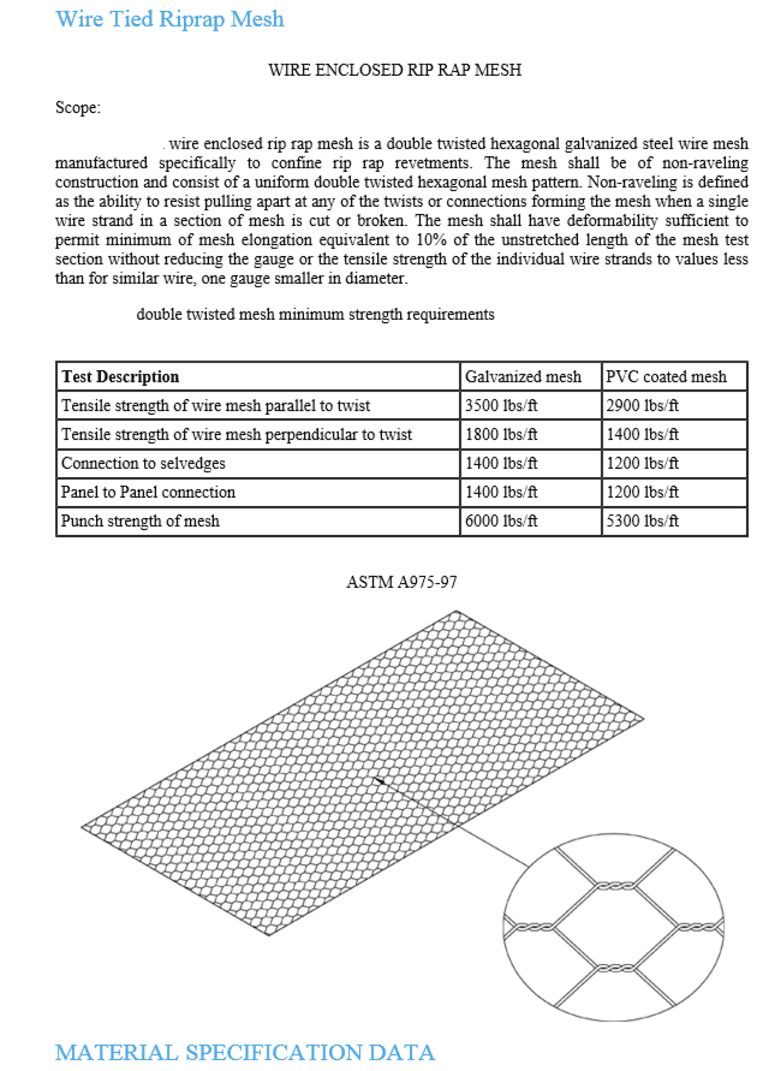WIRE TIED RIP RAP MESH
What Is Rip Rap Erosion Control?
Soil erosion has been a major concern across the globe, especially in sloped areas that receive rainfall throughout the year. There are several solutions to combat soil erosion, each designed for a specific type of erosion. One of the most popular options is rip rap soil erosion control. This measure refers to using a permanent layer of angular stones, boulders, or cobbles to stabilize and protect the soil surface from erosion scour, especially in areas with wave energy or concentrated flow. Rip raps are mostly constructed along channels, shoreline structures, or graded ditches over geotextile to prevent erosional undercutting.
This layer is also mixed with smaller rock materials to build a retention berm used as sediment traps and check dams. This way, they can protect the surrounding area from high-volume culvert inlets. Most rocks used to construct a rip rap range from two to eight inches or even larger depending on the application and installation. When using wire mesh retained rip rap you can utilize smaller stone while free standing rip rap will need to be comprised of much larger stone. The size of rocks needed varies based on the steepness of the slope and the speed of water flow. Rip rap is considered a durable solution to soil erosion and often takes on a natural look while offering habitat for wildlife by creating stable, uneven surfaces.
Common Applications of Rip Rap
While rip rap may not be chosen for aesthetic appeal, it performs exceptionally as a slope stabilization measure and erosion barrier. They are often used in areas where other erosion control measures have failed. The best part about this control practice is that it's easy to install and maintain.
This control practice is used in areas where other forms of erosion control, such as vegetative control, have failed. It provides a defensive line along shorelines, ditch banks, and channels. In some regions, they are also used as high volume/velocity check dams or for sediment trap berms. Rip rap structures are permanent structures and are expensive to construct. With this in mind, the contractor needs to integrate the rip rap construction into the post-construction site design before commencing the project.
Rip rap structures are also constructed along the outer bank of a river bend to dissipate the force of water against the bank. Contractors build them near bridges along the adjacent and embankments to support in-waterways. Soil erosion has several adverse effects, including destabilizing the foundation of a building, washing out adjacent roadways, or compromising the integrity of bridges. Using rip rap is an effective way of keeping people safe.
Pros of Rip Rap
Provides protection against erosion: This measure protects your property and surrounding areas from erosion by stabilizing the soil surface in areas with a high frequency of erosion. Erosion is a gradual process that opens you to several problems, including flooding or pest infestation. Left unchecked, these problems can cause a lot of damage, requiring you to spend a lot to repair them.
Easy to maintain: Rip rap requires annual inspection and maintenance to continue functioning optimally. All you have to do is check for weaknesses or signs of movement and repair them when appropriate. It would be best to inspect them after a major weather-related incident, such as a hurricane or landslide. Replacing the rocks is also simple since most of them are individually placed.
Durable: Rip rap can serve you for a very long time when properly maintained. They are constructed to withstand the elements and be long-lasting.
Cons of Rip Rap
Rip rap is an investment: Rip rap installation is an investment especially when compared to doing nothing. However, it will last and minor damages can easily be fixed using simple tools.
Rip rap depends on your location: Despite being one of the best erosion control practices, it may not be the best for everyone. This control is most useful in areas with high-velocity waters or extremely steep slopes. With calmer bodies of water and gradual slopes, then you can consider other erosion control measures including vegetated erosion control options.







